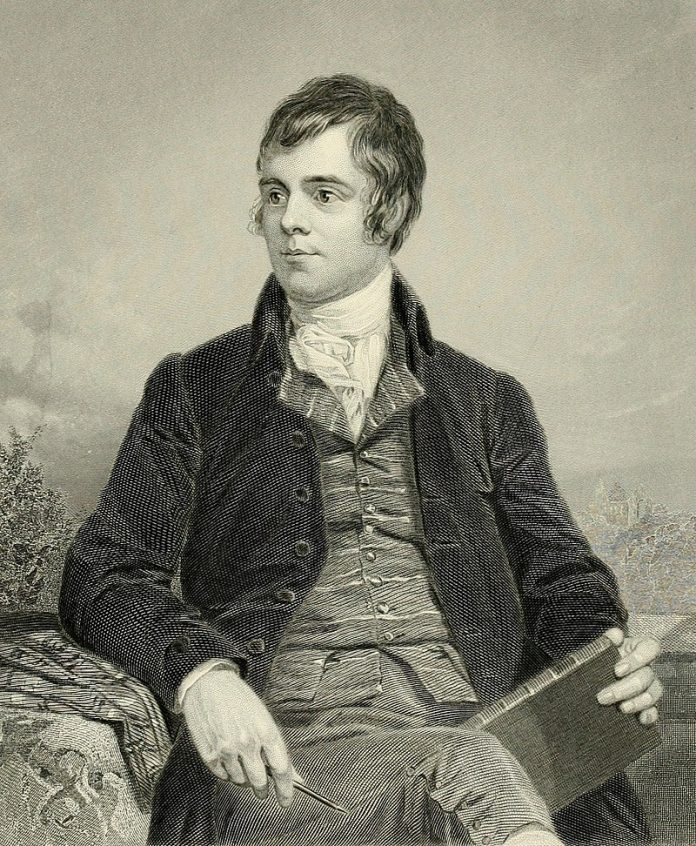(On this birthday of Scotland’s national poet, ’tis fitting that we received this submission from Magda Vanderburg, including a brief analysis of Rabbie Burns’ poem, ‘A Man’s a Man’. We begin with a recorded recital, if ye like. Editor).
Robert Burns, in his song “For a’ that and a’ that” argues that it is not wealth, rank, or lifestyle that makes a man great. Throughout his lines, Burns uses the phrase “an’ a’ that” - as well as similar phrases like “for a’ that” and “For a’ that, an’ a’ that”- but uses these phrases with different effects. The words themselves as well as their contextual meanings form a repetitive pattern used by Burns to manifest, demonstrate and define the egalitarian position the song presents.
In a purely textual sense, the repeated phrases, written with a Scottish accent, are contrasted with the use of plain English throughout most of the song. The speaker begins by asking, “Is there, for honest poverty, That hings his head, an’ a’ that?” (lines 1-2). While the word “hings” and the final phrase both indicate a Scottish lilt, the rest of the line is written in British English. This combination can also be seen in the final stanza, where the speaker expresses his wish: “Then let us pray that come it may, / As come it will for a’ that, /That sense and worth, o’er a’ the earth, / May bear the gree, an’ a’ that” (lines 33-36). The marriage of the plain English and the Scottish work to manifest the egalitarian message of the song. Thus, though some might speak proper English (or what is deemed to be so, Editor), and another might speak with an accent, “A man’s a man for a’ that” (line 12).
Similarly, the phrase itself contains within it a common and unadorned sentiment that echoes the sentiment of the song as a whole. The speaker refers to a young lord and states that he “struts, an’ stares, an’ a’ that” (lines 18). In this, the speaker describes the characteristics of noblemen, then flippantly lumps together all the characteristics with “an’ a’ that.” This same flippancy is expressed for the titles, decorations and “dignities a’ a’ that” (line 30). The speaker, with these phrases, demonstrates through his or her repeated words their honest viewpoint of and disregard for the meaningless ornaments they see in the class system. Instead of “a’ that” (line 34), the speaker exults the “hamely” (line 9) man whose “pith o’ sense, an’ pride o’ worth” (line 31), as well as his honesty (line 15 and 27), make him king-like (line 16). Thus, the ordinariness and dismissiveness of the phrase, “an’ a’ that,” in itself describes the attitude of the song.
Finally, the phrase is utilized to mean different things. The speaker names the highborn attitudes of “yon birkie” (line 17) and that “He’s but a coof for a’ that” (line 20) and this use could be translated to mean “despite all that.” The phrase is used referentially as well, such as when the speaker states that sense and worth “Are higher rank than a’ that” (line 32) in reference to the previous titles and flaunting displays of the lords, princes, marquis and dukes. Finally, the phrase is used to indicate to a continuation of similar ideas, just as the Latin et cetera is used in modern English. For example, the speaker refers to his previous description of the strutting and staring lord and implies a logical continuation of thought as he explains “For a’ that, an’ a’ that, / His riband, star, an’ a’ that” (lines 21-22). All three meanings utilize a similar set of repeating phrases which contextually mean very different things. Just as the speaker hopes “That man to man, the warld o’er, / Shall brothers be for a’ that” (lines 39-40), so to the repeating the phrase, though carrying different meanings, is assembled by the same words. Thus, Burns’ repetition of the phrase “an’ a’ that” highlights the speaker’s argument that men are essentially the same by nature, no matter societal circumstances or accidental qualities.
Burns therefore uses and repeats this iconic phrase throughout his song and in doing so highlights the egalitarian message of the song by contrasting class accents, by echoing the speaker’s sentiment in the phrase itself, and by using the phrase in multiple ways to express different things while using the same words.
Works Cited:
Burns, Robert. “For a’ That and a’ That.” Poetry Foundation, Poetry Foundation, 2022, https://www.poetryfoundation.org/poems/43805/for-a-that-and-a-that.











